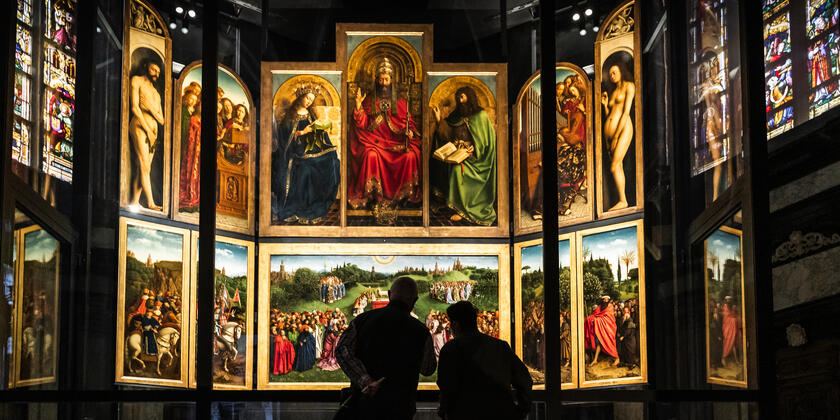

I have looked into about forty references to Jan in historical sources, which is a lot for an artist from the 15th century. There are just seven historical sources referencing Hubert Van Eyck. One important note in the municipal accounts of Ghent concerns a visit to his studio, where his apprentices received some money for their work. He was probably working on the Ghent Altarpiece at that time. Hubert’s tombstone has also been preserved (and is located in St Bavo's Cathedral). Most importantly, he is mentioned on the painting itself.

On the frame of the Ghent Altarpiece, there are four Latin verses saying that Hubert Van Eyck was the first to begin the work and that his brother Jan finished it. This quatrain is authentic. The wood and the paint pigment have been dated, and the language used is correct as well. The Latin and the specific script are fully in line with that of the 1430s. So I do not see any reason why Hubert’s existence should be called into question.
Personnage de légende…
The false rumour that he is a fictional character was spread by a loony art dealer from Bruges, Emile Renders. In 1933, he wrote a book titled Hubert Van Eyck, Personnage de Légende. His theory in a nutshell: the inhabitants of Ghent could not stomach the fact that Jan Van Eyck came from Bruges, so they invented a Ghent brother: Hubert. In this view, the quatrain would be fake, added to the painting at a later point in time.

That last bit is certainly not true, but what about the claim of Bruges versus Ghent? Jan Van Eyck did in fact live in Bruges for quite some time, in the street which is now called Gouden Handrei. He was connected with the court of the Duke of Burgundy and moved in circles of foreign merchants living in Bruges. Hubert was more connected with Ghent, where he was probably registered as a burgher (citizen of the city) and had his own studio.
Emile Renders is the man who claimed that Hubert had been invented by the Ghentians, and he still has true believers. That is the strange thing about the Ghent Altarpiece: the more bizarre the story, the more difficult it is to disprove…
Jan Van Eyck in Ghent
Jan will, without a doubt, have been in Ghent from time to time, but there is no evidence that he ever lived or worked here. Of course, the Ghent Altarpiece had been commissioned by Ghentians for their cathedral, but I can perfectly imagine that Jan finished it in Bruges after Hubert’s death. As such, all this does not matter much. Neither of the brothers had been born in Ghent or Bruges; their native town was Maaseik. Hence their name: Van Eyck. And hence the motto with which Jan often signed his work: “Als ich can” with the Limburg ch.
In a way, Jan could be considered as being from Bruges and Hubert as a Ghentian. That’s a fact. However, Emile Renders turned this into an artistic rivalry between both cities, kind of like between football clubs. That is a complete fabrication. It did not exist at the time and is totally false.
A conspiracy theorist with loyal fans: art historian Emile Renders
One of the people he ripped off was Hermann Göring. During the Second World War, this Nazi bigwig paid 11 million in gold for twenty paintings. Some were authentic, some were fake. After the war, Renders tried to get them back from the authorities, claiming he had been pressured into selling them. In addition, he said, some were forgeries, so he had in fact tried to dupe Göring! In short, he was a real charlatan.
Dealings with Göring
Incidentally, Renders was also the stuff of legend himself. After a failed political career, he acquired an extensive collection of Flemish Primitive paintings in the 1920s. Publicly, he presented himself as a treasure hunter who had an expert eye and could spot masterpieces in the market or in people’s homes like no-one else. Renders had entrepreneurial talent and a sense of PR, but most of the works in his collection turned out to be fake …
But Emile Renders is the man who claimed that Hubert had been invented by the Ghentians, and he still has true believers. That is the strange thing about the Ghent Altarpiece: the more bizarre the story, the more difficult it is to disprove …
Jan Dumolyn
Jan Dumolyn is professor of medieval history at Ghent University. As co-curator of Van Eyck — An optical revolution he re-examined the historical sources relating to the Van Eyck brothers. That was high time, because (too) many myths and half truths about the Ghent Altarpiece are endlessly repeated.




